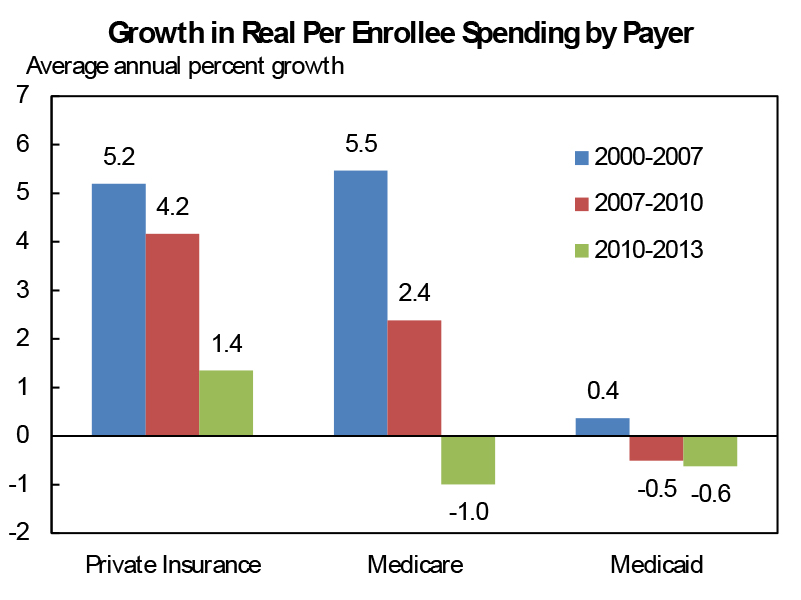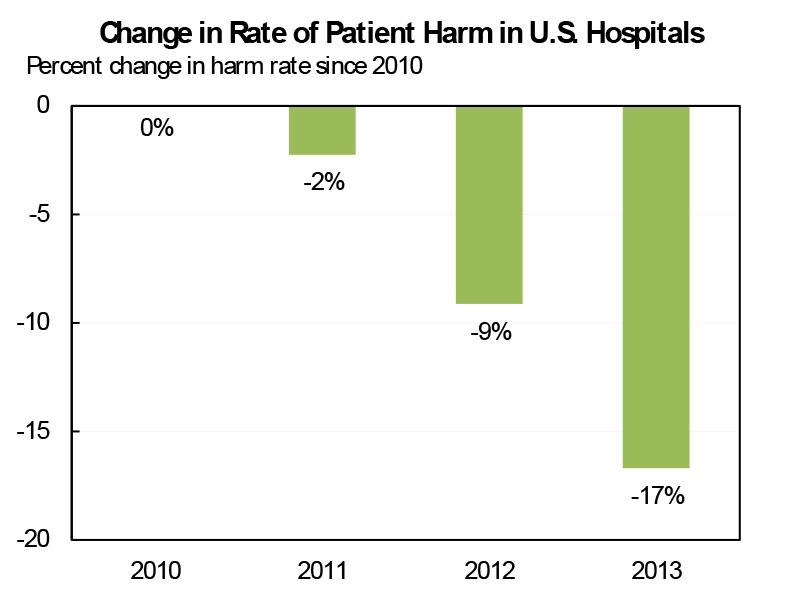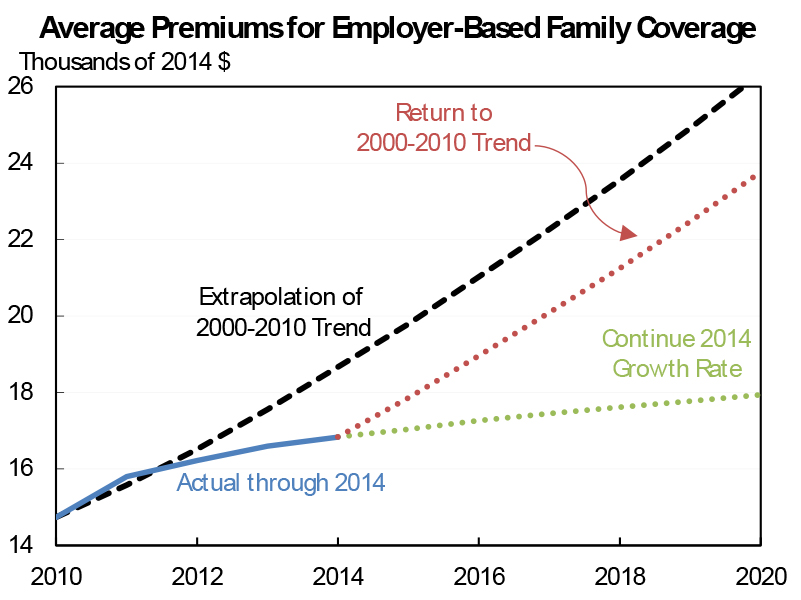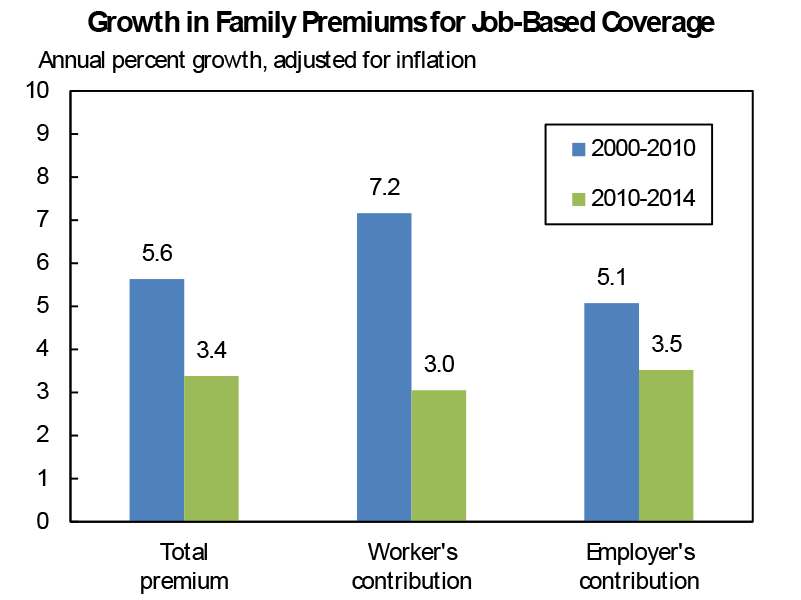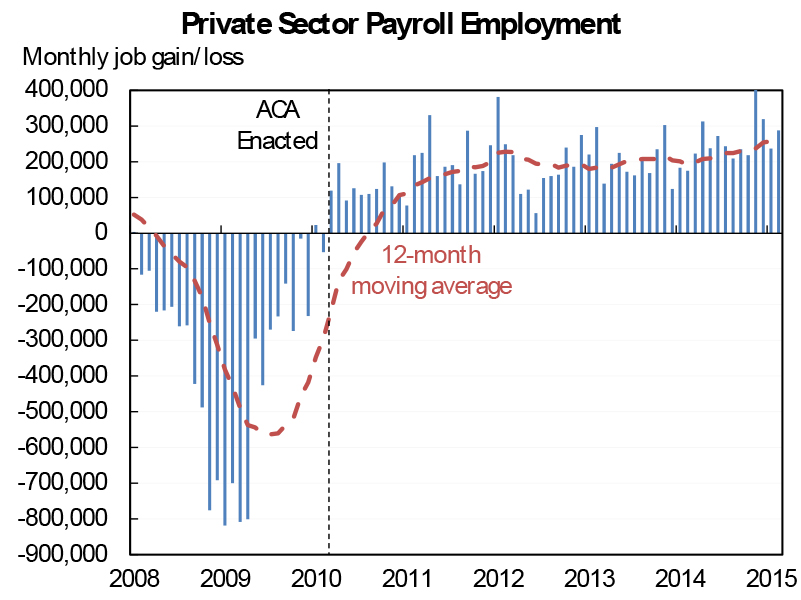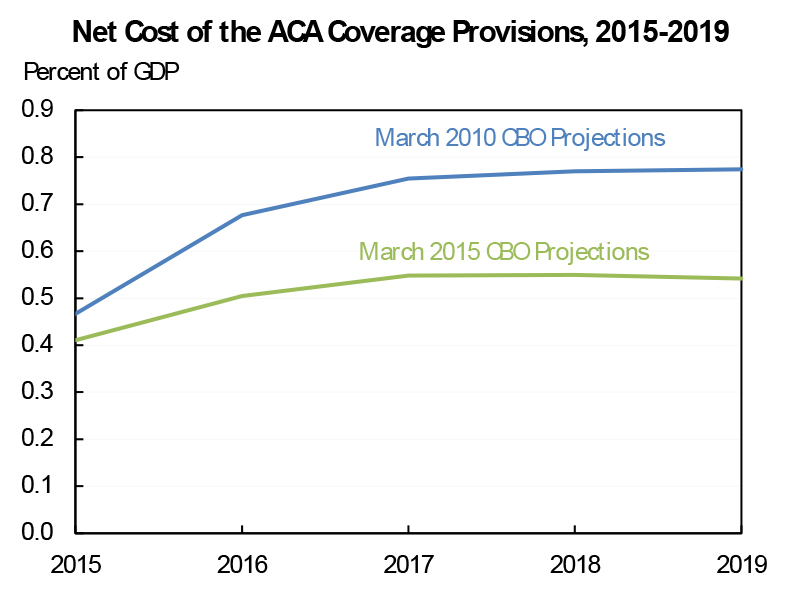
Earlier today, I spoke at the Center for American Progress about the major benefits that the Affordable Care Act is generating for our economy by expanding access to affordable insurance coverage and reforming our health care delivery system to reduce costs and improve quality. This blog post briefly summarizes my remarks, which are available in full here.
Benefits of the Historic Coverage Expansion for Labor Markets and the Macroeconomy
Since the Affordable Care Act’s main coverage provisions took effect at the beginning of 2014, we have seen a precipitous decline in the uninsured rate unlike anything since the decade following the creation of Medicare and Medicaid, and the nation’s uninsured rate now stands at its lowest level ever. A recent analysis by the Department of Health and Human Services indicated that, as of the early months of 2015, an estimated 16.4 million people have gained coverage, including both people who have gained coverage since the end of 2013 and young adults who gained coverage before 2014 due to the law’s option to remain on a parent’s plan until age 26.
Economic research demonstrates clearly that this expansion in coverage is generating major benefits for the newly insured by increasing access to needed care, improving health, and enhancing families’ financial security. But, as I discussed this morning, expanding coverage also has important benefits for the labor market and the macroeconomy:
- Healthier, more productive workers: By improving access to care, the Affordable Care Act is helping people live longer, healthier lives. That means they will miss fewer days of work, be less likely to become disabled, spend more years in the workforce, and be more productive while on the job. Recent evidence bolsters the case that health insurance coverage can have important benefits for long-term labor market outcomes.
- Reduced “job lock”: The Affordable Care Act is improving access to health insurance coverage outside the workplace, reducing “job lock” and improving economic efficiency. Economic research examining earlier coverage expansions affecting young adults suggests that the long-term benefits for workers’ earnings could be substantial.
- Better macroeconomic performance: Expanded coverage is accelerating our recovery from the Great Recession by increasing families’ demand for health care goods and services and reducing their out-of-pocket medical costs, which frees up money to meet other pressing needs. CEA estimates that expanded coverage has created 130,000 jobs in the health care sector as of February 2015, with an even larger effect on employment overall. By safeguarding families’ access to health care and cushioning household budgets in the face of job and income losses, the law will also help reduce the severity of future recessions while better protecting families from their consequences.
Recent Slow Growth in Health Costs and Improvements in Health Care Quality
While one important goal of the Affordable Care Act is expanding access to health insurance coverage, another important goal is addressing long-standing shortcomings of our health care delivery system that have increased costs while undermining health care quality. Recent experience in both areas has been exceptionally encouraging:
- Slower growth in health costs: Since the Affordable Care Act was passed, we have seen the slowest growth in health care prices over any period of that length in nearly 50 years. And thanks to slow growth in per-enrollee health care spending across both the public and private sectors, the three slowest years of growth in real per capita national health expenditures on record were 2011, 2012, and 2013.
-
Improving health care quality: At the same time, various metrics of quality have improved—including a 17 percent reduction in hospital-acquired conditions since 2010 that corresponds to 50,000 avoided deaths from 2010 through 2013, and a sharp reduction in hospital readmissions that translates into 150,000 avoided readmissions in 2012 and 2013.
Although these reductions in health care cost growth and improvements in health care quality have many causes, there is no doubt that the Affordable Care Act is playing a role by reducing excessive payments to medical providers and insurers, reforming provider payments to reward efficient, high-quality care, and helping hospitals to identify and spread best practices.
The implications for the job market and the fiscal outlook if even a portion of that slow health cost growth can be sustained are dramatic. Strikingly, the average family premium in employer-based coverage was about $1,800 lower in 2014 than if growth since 2010 had matched the 2000-10 average, and that difference will widen further if even a portion of the health slowdown continues. If we are able to sustain just one-third of the difference between the 2014 growth rate and the 2000-2010 average, then the average family premium would be an additional $2,100 (in 2014 dollars) below the pre-ACA trend by 2020, for a total of nearly $4,000 in savings.
A range of evidence suggests that significant savings are already being passed along to workers. For example, growth in worker’s premium contributions has slowed even more sharply than growth in total premiums and employers’ premium contributions. Indeed, the average worker contribution to family coverage in 2014 was about $900 below what it would have been had growth matched the 2000-2010 trend. Moreover, in the short run, the premium reductions may also be reducing employers’ compensation costs, helping to boost job growth, while economists expect the full savings to be passed on to workers over time.
Moreover, the deficit reduction associated with the Affordable Care Act and subsequent downward revisions in CBO’s projections of health care spending have been sufficient to cut the 25-year fiscal gap by more than half.
A Look Back at More Than Five Years of Doomsday Predictions
This morning, I also spent a moment reflecting on what the law has not done. During the debate over the law and the years that followed, we heard a stream of predictions that the law would cause economic catastrophe. To put it mildly, these doomsday prophecies have not come to pass.
One popular claim has been that the law would be a “job killer.” To the contrary, starting with the month the Affordable Care Act became law, our businesses have created 12 million new jobs over 60 months of continuous job growth, the longest streak of private-sector job growth on record. And over the last 12 months as the Affordable Care Act’s main coverage provisions have begun to have their full effect, we have created 3.2 million private-sector jobs, the strongest 12-month period of private-sector job growth since 1998. And, from 2013 to 2014, the unemployment rate declined by 1.2 percentage points, the largest annual decline since 1984.
Others said that the law would create a “part-time economy” and drive a major shift toward part-time work. This too has turned out to be false. Since the Affordable Care Act became law, 101 percent of overall increase in employment has been in full-time jobs. In other words, part-time employment has actually declined slightly, even as overall employment has grown steadily.
Likewise, many claimed that the law that was a “budget buster” that would explode deficits. To the contrary, over the past several years, we have seen the federal deficit fall by more than two-thirds as a share of the economy. And, more to the point, the Congressional Budget Office (CBO) has consistently predicted that the law will reduce deficits, particularly long-term deficits, generating savings of more than $1 trillion over two decades. If anything, the law’s fiscal effects are looking better than originally anticipated. Since March 2010, CBO has reduced its estimate of the long-term cost of the law’s coverage provisions by about one-third.
In short, the evidence is clear: Not only have the doomsday predictions of the law’s critics been decisively refuted by events, but the Affordable Care Act is working to expand coverage, reduce costs, and improve quality—all of which are also helping our economy.
Jason Furman is the Chairman of the Council of Economic Advisers.


